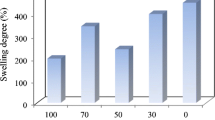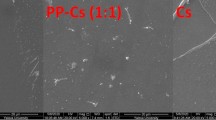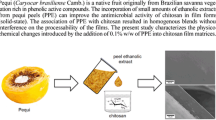Abstract
This paper describes the preparation and characterization of flexible crosslinked chitosan (CH)/poly(vinyl alcohol) (PVA) films. These chitosan-based films are prepared using oxidized pectin as crosslinking agent, and PVA as plasticizer. The chemical structure of the obtained blend films were investigated using FTIR spectroscopy. Swelling behavior of hydrogels obtained was studied in various pH media. The blending of PVA with chitosan or chitosan/oxidized pectin (OP) was found to highly enhance the swelling of the prepared films compared to those obtained from pure chitosan. On the other hand, the use of lactic acid as solvent and the incorporation of PVA improve the flexibility of chitosan matrices. Examination of the hemolytic potential showed that the hydrogels were non hemolytic in nature. The hydrogels were non-toxic and blood-compatible. Reducing power was used to determine in vitro antioxidant activity and anti-inflammatory activity of chitosan films was investigated by protein denaturation method. The biological activity of CH/OP/PVA towards Pseudomonas aeruginosa, Staphylococus aureus, Bacillus subtilis and Escherichia coli has been examined in this study.






Similar content being viewed by others
References
Shehap AM (2008) Thermal and spectroscopic studies of polyvinyl alcohol/sodium carboxy methyl cellulose blends. Egypt J Solids 31:75–91
Ramya R, Sudha PN, Mahalakshmi J (2012) Preparation and characterization of chitosan binary blend. IJSRP 2:1–9
Sugantha Kumari V, Khaleel Basha S, Sudha P N (2012) Physicochemical and morphological evaluation of chitosan/poly(vinyl alcohol)/methylcellulose. Chemically cross-linked ternary blends. Polym Bull 68:1387–1393
Teotia A, Ikram S, Gupta B (2012) Structural characterization of chitosan and oxidized carboxymethyl cellulose based freeze-dried films. Polym Bull 69:175–188
Kim K, Jeong HS, Sung-Koo K (2006) Properties of chitosan films as a function of pH and solvent type. J Food Sci 71:119–124
Nguyen VT, Tran TH (2013) Application of chitosan solutions for rice production in Vietnam. AJB 12:382–384
Rafique A, Mahmoud Zia K, Zuber M, Tabasum S, Rehman S (2016) Chitosan functionalized poly(vinyl alcohol) for prospects biomedical and industrial applications: a review. Int J Biol Macromol. doi:10.1016/j.ijbiomac.2016.02.035
Esam AE, Mohamed MN, Abdul Hamid Y (2010) The preparation and characterization of chitosan/poly (vinyl alcohol) blended films. Eur J Chem 7:1212–1219
Reis EF, Campos F, Lage AP, Leite RC, Heneine LG, Vasconcelos WL, Lobato ZIP, Mansur HS (2006) Synthesis and characterization of poly (vinyl alcohol) hydrogels and hybrids for rMPB70 protein adsorption. Mater Res 9:185–191
Umesh KP, Ashok KN, Birendra KB, Nayak PL (2011) Synthesis and characterization of chitosan-polyvinyl alcohol blended with cloisite 30B for controlled release of the anticancer drug curcumin. JBNB 2:414–425
Mangala E, Suresh Kumar T, Baskar S, Panduranga Rao K (2003) Development of chitosane/poly (vinyl alcohol) blend membranes as burn dressings. Trends Biomater Artif Organs 17:34–40
Esam AE, Mohamed MN, Abdul Hamid Y (2010) Rheological and morphological studies of chitosan/agar/poly (vinyl alcohol) blends. J Appl Sci Res 6:460–468
Parimal M, Arijit G, Sougata J, Nirmal M (2013) Preparation and characterization of maleic anhydride cross-linked chitosan-polyvinyl alcohol hydrogel matrix transdermal patch. JPST 2:62–67
Stoica-Guzun A, Loredana D, Marta S, Iuliana J (2010) Fourier transform infrared (FTIR) spectroscopy for characterization of antimicrobial films containing chitosan. In: Analele UniversităŃii din Oradea Fascicula: Ecotoxicologie, Zootehnie si Tehnologii de Industrie Alimentară, pp 1234–1240
Munarin F, Tanzi MC, Petrini P (2012) Review advances in biomedical applications of pectin gels. Int J Biol Macromol 5:681–689
Judith M, Mariangela B, Augusta C, Tullia T, Geert B, Montse B, Janos P, Bart VD, Kathy E, Stefano S (2016) Pectin content and composition from different food waste streams. Food Chem 201:37–45
Chetouani A, Elkolli M, Bounekhel M, Benachour D (2014) Synthesis and properties of novel hydrogels from oxidized pectin crosslinked gelatin for biomedical applications. Polym Bull 71:2303–2316
Beljit S, Lok P (2008) Development of sterculia gum based wound dressings for use in drug delivery. Eur Polym J 44:3222–3230
Zhen Z, Liu X, Huang T, Xi T, Zheng Y (2015) Hemolysis and cytotoxicity mechanisms of biodegradable magnesium and its alloys. Mater Sci Eng C 46:202–206
Lihong F, Yi S, Weiguo X, Hua Z, Shuhua L (2012) Oxidized pectin cross-linked carboxymethyl chitosan: a new class of hydrogels. J Biomater Sci 23:2119–2132
Alhakmani F, Kumar S, Khan SA (2013) Estimation of total phenolic content, in vitro antioxidant and anti-inflammatory activity of flowers of Moringa oleifera. Asian Pac J Trop Biomed 3:623–627
Senthil K, Jeyaprakash K (2013) In Vitro evaluation of free radical scavenging activity of chitosan. Int J Pharm Life Sci (IJPLS) 4:2685–2690
Umesh KP, Ashok KN, Birendra KB, Nayak PL (2011) Synthesis and characterization of chitosan-polyvinyl alcohol blended with cloisite 30B for controlled release of the anticancer drug curcumin. JBNB 2:414–425
Silverstein RM, Basler GC, Morill TC (1998) Identfication spectrométrique de composés organiques. DeBoeck Université, Belgique
Ramya R, Sudha PN, Mahalakshmi J (2012) Preparation and characterization of chitosan binary blend. IJSRP 2:1–9
Jing W, Nü W, Li W, Hua D, Yong Z, Lei J (2012) Unidirectional water-penetration composite fibrous film via electrospinning. Soft Matter 8:5996–5999
Lihong F, Huan Y, Jing Y, Min P, Jin H (2016) Preparation and characterization of chitosan/gelatin/PVA hydrogel for wound dressings. Carbohyd Polym 146:427–434
Anjali Devi D, Smitha B, Sridhar S, Aminabhavi TM (2006) Dehydration of 1,4-dioxane through blend membranes of poly(vinyl alcohol) and chitosan by pervaporation. J Membr Sci 280:138–147
Dameshek W, Schwartz R (1959) Hemolytic mechanisms. Ann N Y Acad Sci 77:589–614
Friedman AJ, Phan J, Schairer D, Champer J, Qin M, Pirouz A, Blecher K, Oren A, Liu P, Modlin RL (2013) Antimicrobial and anti-inflammatory activity of chitosan-alginate nanoparticules: a targeted therapy for cutaneous pathogens. J. Invest Dermatol 133:1231–1239
Markov PA, Popov SV, Nikitina IR, Ovodova G, Ovodov YS (2011) Antiinflammatory activity of pectins and their galacturonan backbone. Russ J Bioorg Chem 37:817–821
Saso L, Valentini G, Casini ML, Grippa E, Gatto MT, Leone MG, Silvestrini B (2001) Inhibition of heat-induced denaturation of albumin by nonsteroidal antiinflammatory drugs (NSAIDs): pharmacological implications. Arch Pharm Res 24:150–158
Rajalakshmi A, Krithiga N, Jayachitra A (2013) Antioxidant activity of the chitosan extracted from shrimp exoskeleton. Middle East J Sci Res 16:1446–1451
Hima Bindu TVL, Vidyavathi M, Kavitha K, Sastry TP, Suresh Kumar RV (2010) Preparation and evaluation of chitosan–gelatin composite films for wound healing activity. Trends Biomater Artif Organs 24:123–130
Ying-Chien C, Jan-Ying Y, Cheng-Fang T (2011) Antibacterial characteristics and activity of water-soluble chitosan derivatives prepared by the maillard reaction. Molecules 16:8504–8514
Benhabiles MS, Salah R, Lounici H, Drouiche N, Goosen MFA, Mameri N (2012) Antibacterial activity of chitin, chitosan and its oligomers prepared from shrimp shell waste. Food Hydrocolloid 29:48–56
Abu T, Masihul A, Salim R, Tanvir S, Fardous Z, Alamgir ZC, Sabir H (2013) Comparative study of antibacterial activity of chitin and chemically treated chitosan prepared from shrimp (Macrobrachium rosenbergii) shell waste. J Virol Microbiol 2013:1–9
Rejane CG, Douglas B, Odilio BGA (2009) A review of the antimicrobial activity of chitosan. Polimeros 19:241–247
Soo JJ, Manhwan O, Won-Sik Y, Klibs NG, Kwang CJ (2014) Underlying mechanism of antimicrobial activity of chitosan microparticles and implications for the treatment of infectious diseases. PLoS One 9:1–10
Author information
Authors and Affiliations
Corresponding author
Rights and permissions
About this article
Cite this article
Chetouani, A., Elkolli, M., Bounekhel, M. et al. Chitosan/oxidized pectin/PVA blend film: mechanical and biological properties. Polym. Bull. 74, 4297–4310 (2017). https://doi.org/10.1007/s00289-017-1953-y
Received:
Revised:
Accepted:
Published:
Issue Date:
DOI: https://doi.org/10.1007/s00289-017-1953-y




